Revitalizing Choctaw Moccasins
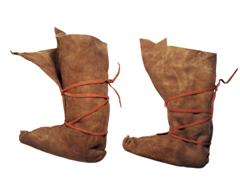
Along with feather bonnets, dream-catchers, and tipis, moccasins are something that the mass media widely associates with Native American people. Unlike these other objects, however, moccasins really are a part of Choctaw traditional culture. Today, a wide variety of moccasins are made, including mass-produced moccasins that come in boxes with marked shoes sizes, mail order moccasins that involve sending in a tracing of your foot to the maker, and custom moccasins made by Indian grandmothers directly to the feet of their families. In most parts of the country, mass-produced and Plains Indian-style moccasins dominate the original traditional Tribal styles. There really is such as thing as Choctaw-style moccasins, but at the time of this writing, you would be hard-pressed to find very many Choctaw feet wearing them. The loss of Choctaw moccasins is sad. The shoes worn by our ancestors are beautiful and comfortable in their own right, are not particularly difficult to make, and look much more in place with a Choctaw shirt or dress than any store-bought moccasin ever could. A number of Tribal members have expressed an interest in learning how to make Choctaw-style moccasins. To meet this request, the Choctaw Nation Historic Preservation Department is beginning to offer classes around southeastern Oklahoma on making them. Who knows, but in a few months, Choctaw moccasins might even start to become a popular indigenous fashion again!
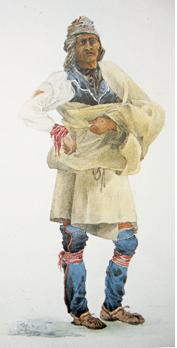
As regular readers of Iti Fabvssa know, Choctaw traditional culture changes and develops over time. In this regard, certain places, such as dry caves, have the ability to preserve objects made from perishable materials for a very long time, and give us look at how some things, such as shoe styles, have changed. Several caves in the central and eastern part of the country have preserved an impressive series of Native American shoes that goes back more than 8,000 years (e.g. Knutruff et. al. 1998). What immediately surprising is that leather moccasins do not appear until the end of the sequence. Instead, the early shoes are different varieties of slippers, made from plant fiber. Today's closest equivalent would be a pair of crocheted houseshoes. Based upon what is found in these caves, in appears that leather moccasins may have began to be common in much of the eastern U.S. about 1000 years ago.
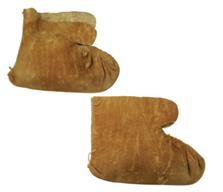
Moccasins can be constructed in several basic ways, and each region and Tribe has its own traditional variety(s). Today, we have three excellent sources for learning about Choctaw moccasins: written descriptions, drawings, and a few pieces surviving in family or museum collections. The following description of Choctaw moccasins was written just before the Trail of Tears:
Their shoes or moccasins are made of deer-skin, deprived of the hair, and exposed to the smoke of a wood fire, till it attains a deep brown color. The moccasin is formed of a single piece of this leather, with one seam behind, and another from the instep to the toe. A flap of about two inches is left round the place where the foot enters, and this flap, together with the seam, is fancifully decorated with beads and porcupine quills dyed blue and red. If worn by a man, it is edged with scarlet hair, - if intended for a woman, it reaches to near the calf of the leg, and is ornamented with red binding or ferret; a moccasin of plain leather is worn in common. (Young 1830:14).
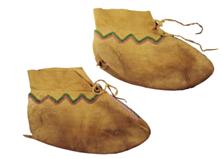
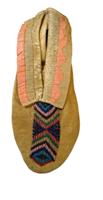
Unfortunately, to the best of the authors' knowledge, no surviving pictures or examples of the early-style high-top Choctaw women's moccasin, mentioned by Young, still exist. However, some of the surviving moccasins made by nearby Tribes are very similar, and give us a great starting point for making the old-style Choctaw women's moccasins (see photo).
Similarly, we can use documented evidence from other Tribes, to suggest that Choctaws also may have applied sticky tree sap to the soles, almost like today's Shoe Goo TM in order to make them more durable.
In the past, our ancestors did not wear their moccasins constantly the same way that we live in our shoes today. Moccasins were worn in cold weather to keep the feet warm, and when traveling through thorns or rough terrain to keep the feet from getting scratched. Around home, they often simply went barefoot (c.f. du Pratz 2006:371 [1758]).
So, what about actually wearing a pair of Choctaw moccasins? They are warm, soft, very light weight, breathe well, are extremely quiet, and fit like gloves. Although they are not waterproof and do not afford sensitive feet the same cushion as a thick rubber sole, they will probably be the most comfortable shoes you have ever put on.
For more information about Choctaw moccasins, and to make a pair of your own, please come to one of the classes hosted by the Choctaw Nation Historic Preservation Department. These will be held at a different location around Choctaw country each month. Enrollment is free, but please bring a pair of scissors if you intend to make moccasins. Hides may be purchased at the time of class for $50. Please call 1-800-522-6170 ext. 2216 to reserve a spot.
References Cited
Du Pratz, Antione Simon Le Page
2006[1758] History of Louisiana: Or of the Western Parts of Virginia and Carolina... Bibliobazaar, U.S.A.
Knutruff, Jenna, S. Gail DeHArt, Michael J. O'Brien
1998 7500 Years of Prehistoric Footwear from Arnold Research Cave, Missouri. Science 281(5373):72-75
Young, F.B.
1830 Natives of the Choktah Tribe of North American Indians. Edinburgh Journal of Natural and Geographical Science 2:13-17.

 Facebook
Facebook Twitter
Twitter YouTube
YouTube



